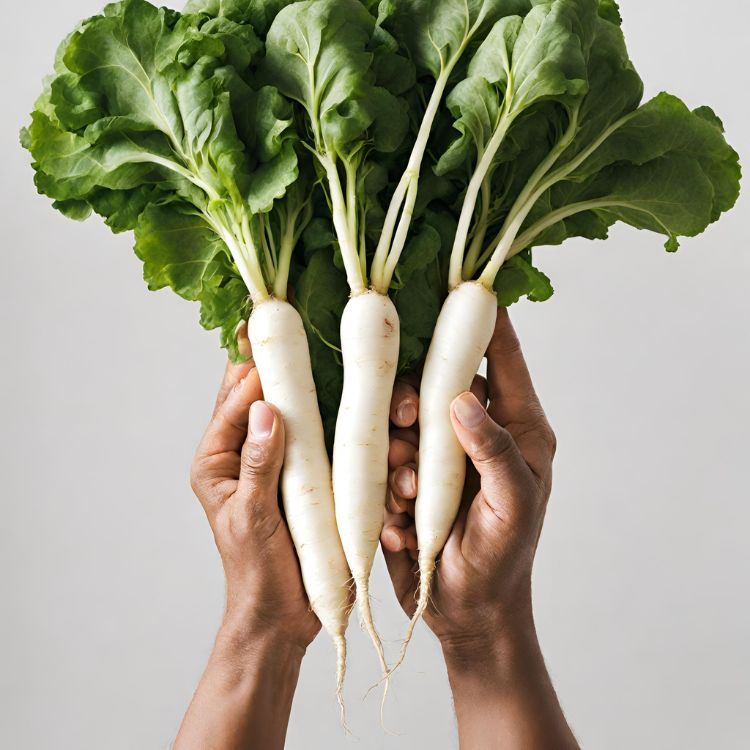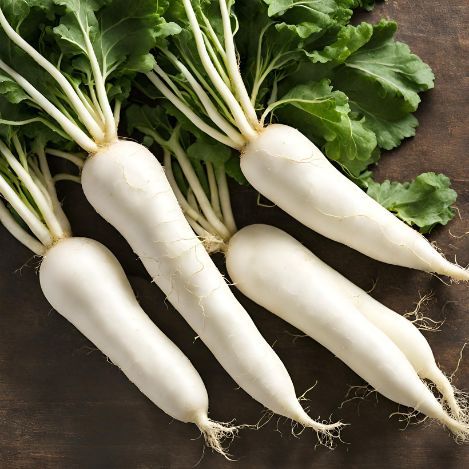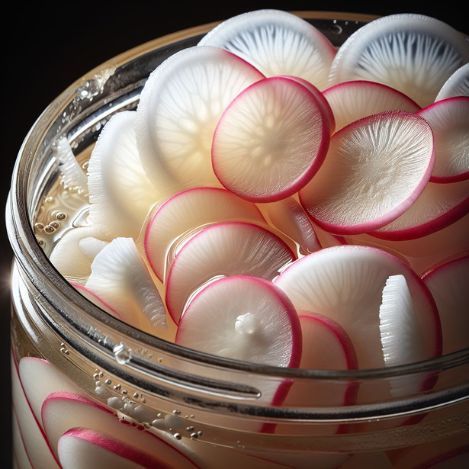
Key Takeaways
White Icicle Radish matures quickly, often ready to harvest in just a month.
Choose a cool, partially shaded spot in your garden for best growth.
Prepare your soil with organic matter to ensure loose, well-draining conditions.
Sow seeds directly in the ground and keep the soil moist for optimal germination.
Succession planting can provide a continuous harvest throughout the growing season.
Discover the White Icicle Radish
Gardening enthusiasts, if you’re looking for a crisp, tasty, and fast-growing vegetable to add to your garden, the White Icicle Radish is an excellent choice. Known for its striking white color and peppery flavor, this radish variety is not only easy to grow but also a delight to the palate.
What Sets White Icicle Radish Apart
What makes the White Icicle Radish stand out is its unique shape and color. It has a slender, tapered form resembling an icicle, with pure white skin and flesh. It’s not just about looks, though. These radishes are known for their crisp texture and mild flavor, making them a favorite for fresh salads and garnishes.
Most importantly, their rapid growth cycle means you can enjoy the fruits of your labor sooner rather than later. Because they grow so quickly, they’re perfect for those of us who can’t wait to see results in the garden.
Quick Growth Cycle: From Seed to Harvest
The White Icicle Radish can go from seed to ready-to-eat in as little as four weeks under optimal conditions. This is particularly appealing for gardeners looking to maximize their yield in a short period. Therefore, it’s ideal for succession planting, ensuring a steady supply of fresh radishes throughout the season.
Getting Started with White Icicle Radish

Before you get your hands dirty, it’s essential to understand the basics of growing White Icicle Radishes. They are cool-season crops that thrive in the milder temperatures of spring and fall. However, with a little planning, you can enjoy them almost all year round.
Selecting the Perfect Spot
To get started, you’ll need to find the right spot in your garden. White Icicle Radishes prefer a location that gets plenty of sunlight but can benefit from partial shade in hotter climates. This will prevent them from bolting to seed too quickly and becoming woody.
Soil Preparation Basics
Good soil preparation is key to growing any vegetable, and White Icicle Radishes are no exception. They prefer loose, well-draining soil rich in organic matter. Here’s a simple guide to preparing your soil:
Start by loosening the soil to a depth of at least 8 inches to allow for proper root development.
Mix in a generous amount of compost or well-rotted manure to provide nutrients.
Ensure the soil is free of stones and large clumps that could obstruct growth.
Check the pH of your soil; radishes prefer a pH between 6.5 and 7.0.
Sowing Your Seeds
Once your soil is ready, it’s time to plant. Sow the seeds directly into the ground, as radishes do not take well to being transplanted. Plant them about 1/2 inch deep and 1 inch apart, in rows spaced about 6 inches apart. After planting, water them gently to settle the soil around the seeds.
Keep the soil consistently moist to encourage germination, which usually occurs within a few days. If the weather is particularly dry, consider using a light mulch to help retain soil moisture.
Remember, the goal here is to inspire you to get out there and plant some White Icicle Radishes. With their ease of growth and quick turnaround, you’ll be crunching on fresh, home-grown radishes in no time. Now, let’s talk about how to care for your radishes once they’ve sprouted.
Watering Wisely
When it comes to watering, consistency is key. White Icicle Radishes prefer soil that is moist but not waterlogged. Aim to provide water to your radishes in the morning so that the foliage has time to dry out during the day, which helps to prevent fungal diseases. If you’re not sure when to water, simply check the top inch of the soil; if it’s dry, it’s time to water.
Thinning for Success
As your radishes sprout, you’ll notice they may be quite crowded. Thinning is necessary to give each radish enough space to grow. When the seedlings are about an inch tall, thin them to about 2 inches apart. You can use the thinnings in salads, so there’s no waste.
Thinning not only prevents overcrowding but also ensures better air circulation around the plants, which is vital for healthy growth and reducing the risk of disease.
Battling Pests and Managing Diseases
White Icicle Radishes are generally trouble-free, but like all plants, they can encounter pests and diseases. Keep an eye out for leaf-eating insects like flea beetles and caterpillars, as well as root pests like root maggots. You can often deter these pests by keeping your garden clean of debris and using floating row covers. As for diseases, good air circulation, crop rotation, and proper watering practices are your best defense.
Succession Planting with White Icicle Radish
Plant a new round of seeds every 10 to 14 days.
Use the quick maturation to your advantage, harvesting some while new seedlings are growing.
Monitor the temperature, as radishes prefer cooler weather.
Plan your last planting to mature before the heat of summer or after the peak of summer has passed.
Succession planting allows you to have a continuous supply of White Icicle Radishes throughout the growing season. By staggering the planting of seeds, you can avoid a glut of radishes all at once and instead enjoy a steady stream of fresh produce.
Keep track of your planting dates and the expected maturity date for each crop. This way, you can harvest radishes at their peak flavor and texture, and you’ll always have young plants developing for future harvests.
Remember, radishes are a cool-weather crop, so if you’re in a warmer climate, you may need to pause your succession planting during the hottest part of the summer. You can resume once the weather starts to cool down again.
Succession planting isn’t just about timing; it’s also about space management. Make sure you have enough room in your garden to accommodate the different stages of growth.
Why Succession Planting Works Wonders
With White Icicle Radishes’ rapid growth, succession planting is particularly effective. It’s a great way to maximize the use of your garden space and keep your soil working for you throughout the season. Plus, it’s incredibly satisfying to see different stages of growth all at once, from sprouting seedlings to fully mature radishes ready for harvest.
How to Time Your Plantings
Timing your plantings is quite straightforward with White Icicle Radishes. Since they mature quickly, you can plant a new round every two weeks. This ensures that as one batch is being harvested, another is growing, and another is being planted. Keep an eye on the weather forecasts, though, because if a heatwave is coming, it’s best to hold off on planting until it passes.
Companion Plants for Radishes
Plant radishes near leaf lettuces, which can provide shade in warmer weather.
Peas and beans are also good companions, as they fix nitrogen in the soil which radishes can use.
Avoid planting radishes near cucurbits like cucumbers and squash, as they can overshadow the radishes.
Companion planting is a clever way to make the most of your garden. Certain plants can help each other grow better when planted nearby. For instance, radishes can deter pests that might otherwise affect squash, and planting them together can help both thrive.
Moreover, radishes can be harvested before these larger plants need more room to spread out, making them excellent companions early in the season.
Harvesting and Enjoying Your Radishes
After all your care and patience, it’s finally time to enjoy the fruits of your labor. White Icicle Radishes are typically ready to harvest when they’re about four to six inches long. You’ll want to pull them up before they get too large, as they can become pithy or too spicy. For those who are eager to enjoy their harvest sooner, consider exploring quick survival garden solutions with veggies that are ready in under 30 days.
Knowing When to Harvest
To determine if your radishes are ready to harvest, simply brush away a bit of soil to check the size of the root. If it’s about an inch in diameter, it’s ready. Gently pull the radish from the soil by grasping the base of the leaves and tugging lightly.
Harvest in the morning when the soil is cool, which will help keep the radishes crisp. After harvesting, remove the leaves if you don’t plan to use them, as they can draw moisture from the roots.
Harvesting your radishes at the right time ensures they have the best flavor and texture. Don’t wait too long, as they can become woody and lose their signature crispness.
Post-Harvest Handling and Storage
Once you’ve harvested your White Icicle Radishes, it’s important to handle and store them properly to maintain their freshness. First, wash the radishes gently to remove any soil. If you’re not planning to eat them right away, store them in the refrigerator. They can be kept in a plastic bag with a paper towel to absorb excess moisture, which helps keep them crisp for up to a week.
If you have a bountiful harvest, consider pickling the radishes for longer storage. Pickled White Icicle Radishes can add a tangy crunch to sandwiches, salads, and more.
Delicious Ways to Enjoy White Icicle Radish

White Icicle Radishes can be enjoyed in a variety of ways. Here are a few ideas to get you started: consider incorporating them into surprising uses for common items in your garden.
Slice them thinly and add to salads for a peppery crunch.
Pickle them with vinegar, sugar, and spices for a tangy condiment.
Grate them into coleslaw or potato salad for extra zing.
Serve them with a creamy dip as a refreshing appetizer.
Roast them with other root vegetables for a hearty side dish.
Don’t forget that the greens are edible, too. Sauté them with garlic and olive oil for a nutritious addition to your meal.
Frequently Asked Questions
How long does it take for White Icicle Radish to mature?
White Icicle Radishes are known for their quick maturation. Under optimal growing conditions, they can be ready to harvest in as little as 21 to 30 days after planting. Keep an eye on the size and don’t let them grow too large to ensure the best flavor.
Can White Icicle Radish be grown in containers?
Absolutely! White Icicle Radishes are well-suited for container gardening. Make sure to choose a container that is at least 6 inches deep and has good drainage. Keep the soil moist and thin the seedlings as needed. Container gardening is a great option if you have limited space.
What is the ideal soil temperature for planting White Icicle Radish?
The ideal soil temperature for planting White Icicle Radish seeds is between 45°F and 85°F (7°C to 29°C). They can germinate in cooler soil, but the ideal range will give you the quickest and most consistent results.
How often should White Icicle Radish be watered?
White Icicle Radishes should be watered regularly to maintain even soil moisture. Aim for about 1 inch of water per week, whether through rainfall or manual watering. In hot, dry weather, you may need to water more frequently to prevent the soil from drying out.
What are some common pests that affect White Icicle Radish?
While White Icicle Radishes are relatively easy to grow, they can be affected by a few common pests:
Flea beetles: Small, jumping insects that chew tiny holes in the leaves.
Root maggots: Larvae that feed on the roots, causing damage and stunted growth.
Aphids: Tiny insects that suck sap from the leaves, potentially spreading disease.
To combat these pests, maintain a clean garden environment, utilize row covers to shield your plants, and rotate your crops regularly. If you encounter pest problems, consider using organic pesticides or introducing beneficial insects like ladybugs into your garden ecosystem. For further information and to explore our range of high-quality seeds, visit Survival-Essentials.







Leave a Reply